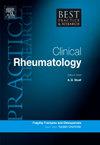急性风湿热和链球菌后反应性关节炎。
IF 4.8
2区 医学
Q1 RHEUMATOLOGY
Best Practice & Research in Clinical Rheumatology
Pub Date : 2025-05-01
DOI:10.1016/j.berh.2025.102067
引用次数: 0
摘要
急性风湿热(ARF)和链球菌后反应性关节炎(PSRA)是两种不同但相关的链球菌后疾病,两者都是由A群链球菌(GAS)感染后的自身免疫反应引起的,通常是咽炎。虽然这两种疾病有共同的诱因,但它们的临床表现和长期后果却有明显不同。ARF是一种全身性炎症性疾病,可影响几个器官,特别是心脏,可能导致慢性风湿性心脏病,并伴有不可逆的瓣膜损伤。ARF治疗的基础包括链球菌根除治疗、症状管理和预防复发的二级预防。相比之下,PSRA主要表现为非感染性、非迁移性、无心脏炎的持续性关节炎,通常无持久后遗症。区分PSRA和ARF对于适当管理和避免不必要的长期抗生素预防至关重要。本文综述了ARF和PSRA的主要临床特征和诊断方法,并概述了它们的治疗策略。本文章由计算机程序翻译,如有差异,请以英文原文为准。
Acute rheumatic fever and Post-streptococcal reactive arthritis
Acute rheumatic fever (ARF) and poststreptococcal reactive arthritis (PSRA) represent two distinct but related poststreptococcal conditions, both arising from an autoimmune response following Group A streptococcal (GAS) infection, typically pharyngitis. Although both illnesses have a shared trigger, their clinical presentations and long-term consequences differ markedly. ARF, a systemic inflammatory disorder, can impact several organs, particularly the heart, potentially resulting in chronic rheumatic heart disease with irreversible valve damage. The cornerstone of ARF treatment includes Streptococcus eradication therapy, symptom management, and secondary prophylaxis to prevent recurrence. In contrast, PSRA primarily presents as non-infectious, nonmigratory, persistent arthritis without carditis and generally resolves without lasting sequelae. Distinguishing PSRA from ARF is crucial for appropriate management and to avoid unnecessary long-term antibiotic prophylaxis. This review focuses on the key clinical features and diagnostic approaches for ARF and PSRA, along with an overview of their management strategies.
求助全文
通过发布文献求助,成功后即可免费获取论文全文。
去求助
来源期刊
CiteScore
9.40
自引率
0.00%
发文量
43
审稿时长
27 days
期刊介绍:
Evidence-based updates of best clinical practice across the spectrum of musculoskeletal conditions.
Best Practice & Research: Clinical Rheumatology keeps the clinician or trainee informed of the latest developments and current recommended practice in the rapidly advancing fields of musculoskeletal conditions and science.
The series provides a continuous update of current clinical practice. It is a topical serial publication that covers the spectrum of musculoskeletal conditions in a 4-year cycle. Each topic-based issue contains around 200 pages of practical, evidence-based review articles, which integrate the results from the latest original research with current clinical practice and thinking to provide a continuous update.
Each issue follows a problem-orientated approach that focuses on the key questions to be addressed, clearly defining what is known and not known. The review articles seek to address the clinical issues of diagnosis, treatment and patient management. Management is described in practical terms so that it can be applied to the individual patient. The serial is aimed at the physician in both practice and training.

 求助内容:
求助内容: 应助结果提醒方式:
应助结果提醒方式:


